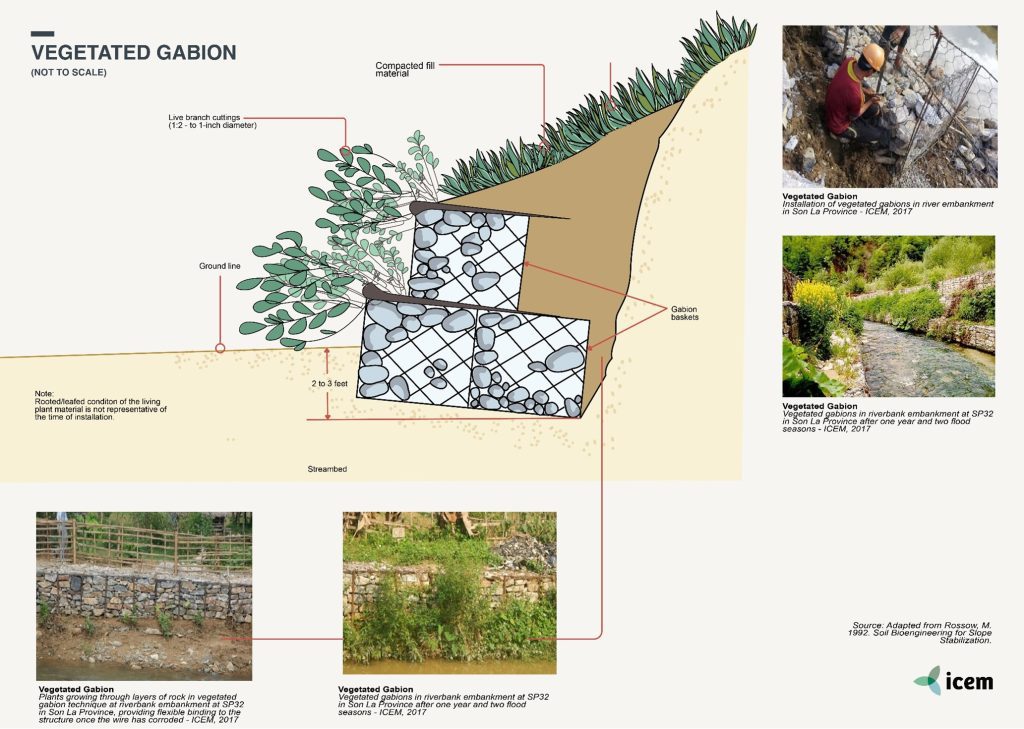| Suburban and urban | River | Medium-cost | Riverbank erosion | |
| DESCRIPTION | |
| Measures
|
Gabions are rectangular baskets fabricated from a hexagonal mesh of heavily galvanized steel wire. Empty gabions are placed in position at the site, wired together with adjoining gabions, filled with rocks, and then the top is folded down and wired shut at the ends and sides. Gabions can be piled up in layers on top of each other and are effective where the bank slope is steep (typically greater than 1.5:1) and requires structural support, or to support the bank to where a low wall may be required to stabilize the slope. They can also be used when the design for rock riprap requires a rock size greater than what is locally available. Live vegetation, comprising branches usually from 2 to 6 cm in diameter is included when the baskets are being filled by placing posts and poles through the baskets so that they penetrate the fill or native soil behind the gabions. The space between the stones in the baskets may also be filled with soil and seeded to promote vegetation growth within and between the baskets and the underlying backfill or soil. Once the root structures develop, they bind the gabions to the bank and the emerging plants improve the aesthetics and create a natural habitat. |
| Location | Gabions are suitable for providing support to banks subject to shallow to intermediate earth deformations. For deeper slip failures a gravity retaining wall may be required subject to a geotechnical analysis. The presence of vegetation on the lowest gabion layers increases the overall stability. |
| Design options and performance | Lower initial cost than a concrete structure and they should be avoided where streambed material might abrade and cause rapid failure of gabion wire mesh. Gabions are useful where space is limited and a more vertical structure is required but is not intended to resist large, lateral earth stresses. Where gabions are designed as a structural unit, the effects of uplift, overturning, and sliding must be analyzed like that for gravity-type structures. A filter is usually required between the gabions and the foundation or backfill to prevent soil movement through the basket |
| Feasibility criteria
|
● Technical design: The design for a gabion structure must take into consideration (i) foundation stability including both geotechnical and shear forces on the structure (ii) the shear forces that the gabion face must withstand from the determined water flow velocity and (iii) protection measures for the toe and flanks of the structure. The stone size selected for the gabions must be able to withstand the shear forces exerted by the water without deformation. There are two options for dealing with scour; either the bottom level of gabions must be placed below the maximum scour depth or a gabion mattress can be placed at the toe to protect it from scour. For vegetated gabions, live branch cuttings are placed on the wire baskets perpendicular to the slope with the growing tips pointing away from the slope and extending slightly beyond the gabions. The live cuttings must extend behind the backs of the wire baskets into the fill material. Soil is placed over the cuttings and compacted.
● Soil media: n/a ● Soil slope: Gabions can be used to support steep banks ● Surface cover: n/a ● Materials: Galvanised wire mesh, stone, live cuttings. Gabions are usually constructed in situ entirely manually but in some cases, it may be convenient to fabricate the gabions on top of the bank and then crane them into place as a unit, below water if necessary. |
| Operation and maintenance | Once the vegetation has become established little maintenance will be required beyond an inspection of the gabion structure after floods to check for damage to the wires or distortion. |
| Cost and benefits | Low to medium cost, provided suitable stone is locally available and the work does not involve diversion of major water courses or affect existing infrastructure. Vegetated gabions provide effective support to eroding river banks and in time the plants will spread over the structure adding strength and creating habitat and increasing biodiversity. |
| Design solution
|
Vegetated gabions are a simple and low-cost solution for stabilizing slopes and preventing erosion of river banks. They combine the benefits of green and grey technologies to provide maximum structural protection, erosion control, vegetation growth, and vegetation reinforcement in one system. Vegetated gabions are very useful for applications on fast-flowing rivers where high hydraulic pressures can typically undermine vegetation growth. |
| Environmental performance | Vegetated Gabions provide an important bioengineering solution for soil stabilization since they allow for the growth and establishment of natural vegetation while providing strong protection from the onset. In many situations where hard-grey solutions for river bank protection such as concrete and riprap were once widely accepted, vegetated gabions can provide a more cost-effective, aesthetically pleasing, and environmentally acceptable solution. Once a dense plant system is established the gabion wall structure can be covered by vegetation thus creating a natural river bank appearance and a habitat for wildlife. |
| Sources | ● ICEM, 2017. Slope Protection Designs and Specifications, TA-8102 VIE: Promoting Climate Resilient Rural Infrastructure in Northern Vietnam, Technical Report No. 18. Prepared for Ministry of Agriculture and Rural Development and Asian Development Bank. Hanoi.
● ICEM, 2017. Promoting Climate Resilient Rural Infrastructure in Northern Viet Nam, Technical Report 17: Technical Guidelines for Slope Protection. Prepared for the Ministry of Agriculture and Rural Development and Asian Development Bank. Hanoi. ● LaRiMiT – Norwegian Geotechnical Institute (NGI). 2016. NBS for Erosion Control. ● Mississippi Watershed Management Organization, 2017. A Guide to Bank Restoration Options for Large River Systems: Part II Bioengineering Installation Manual. ● United States Department of Agriculture, Natural Resources Conservation Service, 1996. Engineering Field Handbook – Chapter 16, Streambank and Shoreline Protection. |
Download PDF
Originally developed under the ADB ‘TA-9417 VIE: Secondary Green Cities Development Project – Output 2: Demonstrated sustainable and resilient development in Hue, Ha Giang and Vinh Yen’. Adapted for the UN-CTCN project ‘Climate risk assessment for subnational adaptation and establishment of a local climate information system for climate change adaptation (LISA) in Cambodia’.



